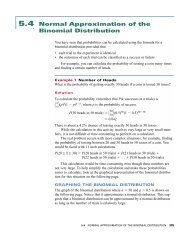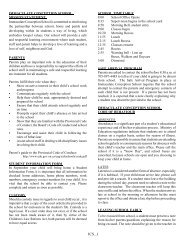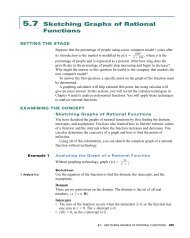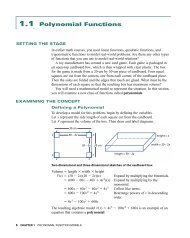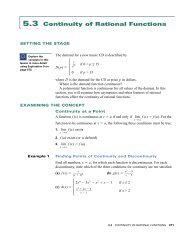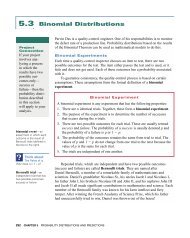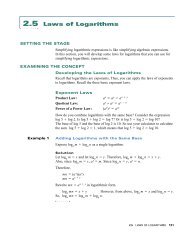Pg 465
Pg 465
Pg 465
You also want an ePaper? Increase the reach of your titles
YUMPU automatically turns print PDFs into web optimized ePapers that Google loves.
2x<br />
<br />
x 60 2 1000<br />
2x<br />
<br />
x 60 2 1 000<br />
1 0<br />
1<br />
<br />
2x x 60 2 1000<br />
4x 2 x 2 160 000<br />
3x 2 160 000<br />
00<br />
0<br />
x ± <br />
160 3<br />
x 230.94<br />
<br />
Add 1 to each side.<br />
Multiply each side by x 60 2 1.<br />
000<br />
Square both sides.<br />
Isolate x 2 .<br />
Solve for x.<br />
Since x ≥ 0, the negative solution is<br />
inadmissible.<br />
Intervals<br />
0 ≤ x < 230.94 230.94 < x ≤ 3000<br />
C ′(x) – +<br />
C(x) decreasing increasing<br />
The first derivative test confirms that a global minimum occurs at x 230.94.<br />
This value is the distance from the point on the shore closest to the island to the<br />
point where the cable enters the water. This distance will minimize the cost of<br />
installing the cable. Using this value, calculate L 1<br />
and L 2<br />
.<br />
L 1<br />
(230.9 4) 160 2 0 00 L 2<br />
3000 230.94<br />
461.88 2769.06<br />
The total cost of laying the cable is minimized if about 2769.06 m are placed<br />
along the shore and 461.88 m are placed underwater.<br />
→<br />
minimum at x = 230.94<br />
→<br />
CHECK, CONSOLIDATE, COMMUNICATE<br />
1. Why do optimization problems involving distance often result in using<br />
the chain rule<br />
2. Suppose you have found the model for a problem. Is determining the<br />
optimal values of a composite function different from determining the<br />
optimal values for polynomial and rational functions Explain your<br />
answer in terms of techniques.<br />
KEY IDEAS<br />
• The properties of the derivative that you use to solve optimization<br />
problems involving composite functions are the same as those you apply<br />
to polynomial and rational functions.<br />
• Use the strategy for solving optimization problems, outlined in Chapters 4<br />
and 5 on pages 305 and 397, to also solve problems involving composite<br />
function models.<br />
470 CHAPTER 6 RATES OF CHANGE IN COMPOSITE FUNCTION MODELS



